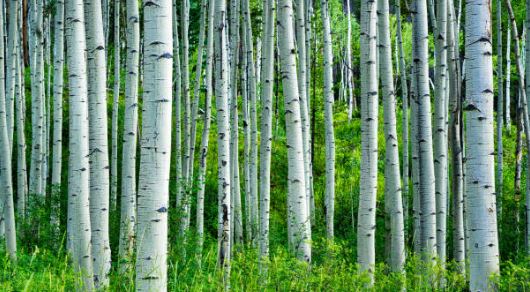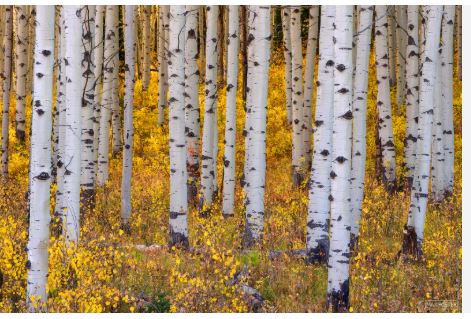
Aspen trees, belonging to the genus Populus in the Salicaceae family, are deciduous hardwoods renowned for their shimmering leaves, striking bark, and vibrant fall colors. Native to temperate and boreal regions of the Northern Hemisphere, these fast-growing trees thrive in forests, mountains, and disturbed sites, often forming expansive clonal groves through root suckering. Their name derives from the Old English “æspe,” reflecting their trembling leaves, which flutter in the slightest breeze due to flattened petioles.
Aspen trees are identified by their smooth, pale gray to white bark with black lenticels or scars (except black poplar’s furrowed bark), and rounded to ovate, serrated leaves (1–5 inches) that tremble in breezes due to flattened petioles, turning yellow-orange (rarely red) in fall. Dioecious, they produce male and female catkins in spring, with wind-pollinated seeds in cottony tufts.
Trees range from 20–100 feet tall, with open to narrow canopies, and spread via root suckers, forming clonal groves. They thrive in moist, well-drained, acidic to neutral soils, preferring full sun and tolerating cold but not heavy shade or drought. Their fast growth (2–5 feet/year) and clonal habit are distinctive.
Aspens support wildlife, with leaves and bark feeding deer, elk, and beavers, and catkins sustaining birds like grouse. They host butterfly caterpillars (e.g., mourning cloak) and stabilize soil in disturbed areas. Clonal groves enhance biodiversity, with quaking aspen groves like Pando being among Earth’s largest organisms.
Culturally, aspen wood is used for paper, pallets, and matches, while Native Americans used bark for medicine and folklore tied aspens to communication due to their “whispering” leaves. Their golden fall displays make them ornamental favorites in parks and gardens.
Plant aspens in full sun with moist, well-drained, acidic to neutral soils, avoiding heavy clay or drought-prone sites. Quaking and bigtooth aspens suit colder climates, while black poplar tolerates wetter soils. They’re fast-growing but short-lived (50–150 years), prone to pests like borers and diseases like cankers.
Regular watering aids young trees; pruning prevents suckering in lawns. Climate change may stress southern populations, so choose hardy cultivars like ‘Prairie Gold’ (quaking aspen). Store seeds at 40°F for short-term planting, as viability is brief. Rare types like Chinese aspen are at specialty nurseries.

Types of Aspen Trees Varieties
Quaking Aspen (Populus tremuloides)
Native to North America, quaking aspen spans from Alaska and Canada (Newfoundland to British Columbia) to northern Mexico, covering the U.S. from New England to California, thriving in USDA zones 1–7. Found in boreal forests, montane regions, and disturbed sites up to 10,000 feet, it forms the largest clonal groves, like Utah’s Pando (43 hectares, 80,000 years old).
Growing 20–80 feet tall and 10–30 feet wide, it has smooth, white to pale gray bark with black scars, darkening with age. Leaves are rounded, 1–3 inches, with finely serrated margins, glossy green, turning golden-yellow (rarely red) in fall, trembling in breezes. Catkins bloom in spring, with wind-pollinated seeds. It prefers moist, well-drained, acidic to neutral soils, tolerating cold but not drought or shade. Its fluttering leaves and clonal growth distinguish it from other aspens.
European Aspen (Populus tremula)
The European aspen is native to Europe, from Scandinavia to the Mediterranean (excluding southern Iberia), and extends to Western Asia (Turkey, Siberia) and North Africa, growing in USDA zones 2–7. It thrives in boreal and temperate forests, meadows, and hillsides up to 6,500 feet, often in mixed stands with birch or pine.
Reaching 30–100 feet tall and 20–40 feet wide, it has smooth, pale gray-green bark with diamond-shaped lenticels, turning furrowed with age. Leaves are rounded to ovate, 1–4 inches, coarsely toothed, bronze when young, green in summer, and yellow-orange in fall, trembling like quaking aspen. Spring catkins produce cottony seeds. It favors moist, well-drained soils, tolerating poor conditions and cold but not heavy shade. Its coarser leaf margins set it apart from quaking aspen.
Bigtooth Aspen (Populus grandidentata)
Native to eastern North America, from Nova Scotia to Ontario, south to Virginia, and west to Minnesota, bigtooth aspen grows in USDA zones 3–6. It inhabits mixed hardwood forests, clearings, and disturbed sites like old fields, often at lower elevations than quaking aspen. Growing 30–60 feet tall and 20–30 feet wide, it has smooth, gray-green bark, becoming furrowed and darker with age.
Leaves are large, ovate, 2–4 inches, with large, irregular teeth, dark green above, paler beneath, turning bright yellow in fall, with less trembling than quaking aspen. Spring catkins yield cottony seeds. It prefers well-drained, sandy or loamy soils, tolerating drier conditions than quaking aspen but not deep shade. Its coarse, toothed leaves are distinct from other aspens.
Chinese Aspen (Populus adenopoda)
Native to central and eastern China, from Jiangsu to Yunnan, the Chinese aspen grows in temperate forests, river valleys, and mountain slopes up to 8,000 feet in USDA zones 5–8. Less common in cultivation, it reaches 50–80 feet tall and 20–40 feet wide, with a straight trunk and open canopy. Its bark is smooth, pale gray, with black lenticels, becoming rougher with age.
Leaves are ovate to rhombic, 2–5 inches, finely serrated, glossy green, turning yellow in fall, with moderate trembling. Spring catkins produce seeds with cottony tufts. It thrives in moist, well-drained, slightly acidic soils, tolerating wetter conditions than European aspen. Its rhombic leaves and East Asian origin distinguish it from North American aspens.
Korean Aspen (Populus davidiana)
Native to northeastern Asia, including Korea, northern China, Mongolia, and eastern Siberia, the Korean aspen grows in boreal forests, mountain slopes, and riverbanks up to 9,000 feet in USDA zones 3–7. Reaching 50–100 feet tall and 20–40 feet wide, it forms a narrow, upright canopy. Its bark is smooth, pale gray to greenish, with small lenticels, darkening with age.
Leaves are ovate, 2–4 inches, finely toothed, glossy green, turning yellow-orange in fall, with slight trembling. Spring catkins yield cottony seeds. It prefers moist, well-drained soils, tolerating cold and poor soils but not prolonged drought. Its narrower canopy and Asian range set it apart from the broader European aspen.
Japanese Aspen (Populus sieboldii)
Native to Japan, particularly Hokkaido and Honshu, and parts of Korea, the Japanese aspen grows in temperate forests, mountain slopes, and river valleys up to 6,000 feet in USDA zones 4–7. Growing 30–60 feet tall and 20–30 feet wide, it has a rounded canopy and slender trunk. Its bark is smooth, pale gray to white, with black lenticels, becoming slightly furrowed.
Leaves are rounded to ovate, 2–4 inches, finely serrated, glossy green, turning yellow in fall, with pronounced trembling. Spring catkins produce cottony seeds. It thrives in moist, well-drained, acidic soils, tolerating partial shade but not heat. Its smaller size and Japanese origin distinguish it from the taller Korean aspen.
Black Poplar (Populus nigra)
Though often classified separately, black poplar includes aspen-like subspecies (e.g., Populus nigra subsp. caudina) and is sometimes grouped with aspens due to similar traits. Native to Europe, Western Asia, and North Africa, from Britain to Kazakhstan, it grows in floodplains, riverbanks, and wetlands in USDA zones 3–9.
Reaching 60–100 feet tall and 30–50 feet wide, it has a broad, irregular canopy. Its bark is dark gray, deeply furrowed, unlike aspen’s smooth bark. Leaves are triangular, 2–4 inches, finely serrated, dark green, turning yellow in fall, with minimal trembling. Spring catkins yield cottony seeds. It prefers wet, well-drained soils, tolerating flooding but not drought. Its furrowed bark and triangular leaves set it apart from quaking aspen.